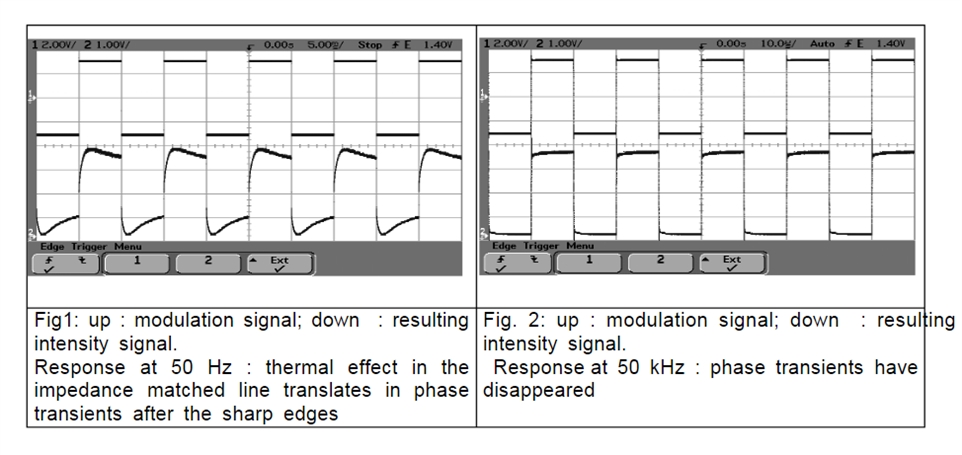

LiNb03 modulators are widely used for their high bandwidth performances that make them favored devices for high data rate optical communications (up to 40 Gb/s) and high frequency (20 GHz) analog transmission. They are less often used at low frequencies under 1 GHz. However LiNb03 phase modulators have also strong benefits at low frequencies (compactness, ease of use, low drive voltage) compared to devices based on alternative technologies and are thus components to be considered even for kHz to MHz frequency range applications. Users searching to implement LiNb03 phase modulators with modulation signals showing low and high frequency components, and the typical case is the one of a pulse signal with sharp rising and fall edges and low repetition rate or long pulse duration, must be very cautious. A “high bandwidth” phase modulator, and here “high bandwidth” means > 1 GHz typically, is not performing extremely well with such a modulation signal. The reason is that in order to get good high bandwidth performance, the impedance of the microwave line of the modulator is matched near to 50 ohms and a load resistance termination is connected at the end of the RF line to reduce or avoid electrical RF reflection. Thus, a significant level of current is traveling in the RF electrodes, leading to local temperature increases by Joule effect. Heating and thermal dissipation becomes a problem when the repetition period or the pulse duration becomes longer than the time constant of the thermal effects (in the range of 1kHz or below). Then the physical properties of the electrodes and waveguide are changing during the heat-on and cool-down periods, leading to unwanted phase drifts. Standard 5, 10 or 20 GHz phase modulators are not suitable for such applications involving very low repletion rate. To suppress that phenomenon, a solution is to use a modulator with a high input impedance load (typ 10 kΩ) or directly an opened electrode line (MΩ). The useful E-O bandwidth is then reduced to several hundred MHz which is sufficient for a large range of applications in particular for sensing applications, but the thermal effects are significantly reduced since the Joule effect becomes negligible. Photline has developed a family of phase modulators whose performances are optimized for low repetition rate modulation signals (MPX-LN-0.1 series are available at 800 nm, 1000 nm, 1300 nm, 1550 nm). MPX-LN-0.1 modulators has been tested in temperature and it has been demonstrated that they keep their performance in operating conditions covering a large temperature range (-40°C +85°C) and during temperature variations.
Example : Birefringent phase modulator.
A titanium in-diffused phase modulator can support both TE and TM states of polarization. By orienting the input polarization at 45° from the main axes of the waveguide, it is hence possible to illuminates simultaneously the TE and TM modes of the phase modulator. Phase modulation occurs differentially for the two modes. An output analyzer parallel or perpendicular to the input polarizer converts the relative phase variations into intensity variations that are detected with a photodiode.
Fig.1 and Fig.2 below show the modulation obtained when a rectangular modulation signal is applied to the high frequency phase modulator (MPZ-LN-20 type) at 50 Hz and at 50 kHz. The effect of thermal effect is clearly visible in fig.1 at very low frequency. At 50 kHz the thermal effect totally vanishes.Example : Birefringent phase modulator.

For operation at lower frequencies (<1 GHz) with electrical signals involving very low frequency components, a lumped electrode modulator (MPX-LN-0.1 type) can be efficiently used. In such modulators, no load resistor terminates the electrodes. Fig. 3 and Fig.4 below show the same modulation signal applied to a MX-LN-0.1 phase modulator The modulation is obtained with purely capacitive electrodes involving no thermal effect.